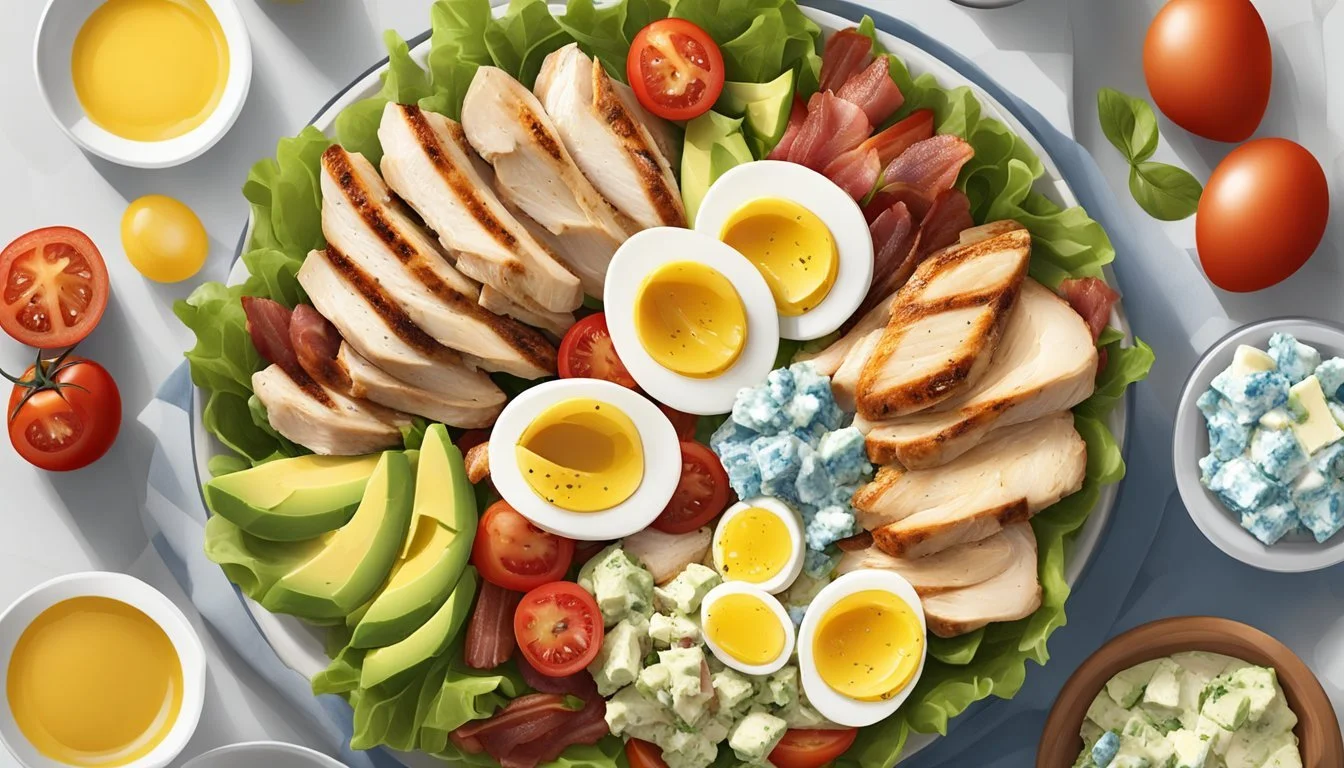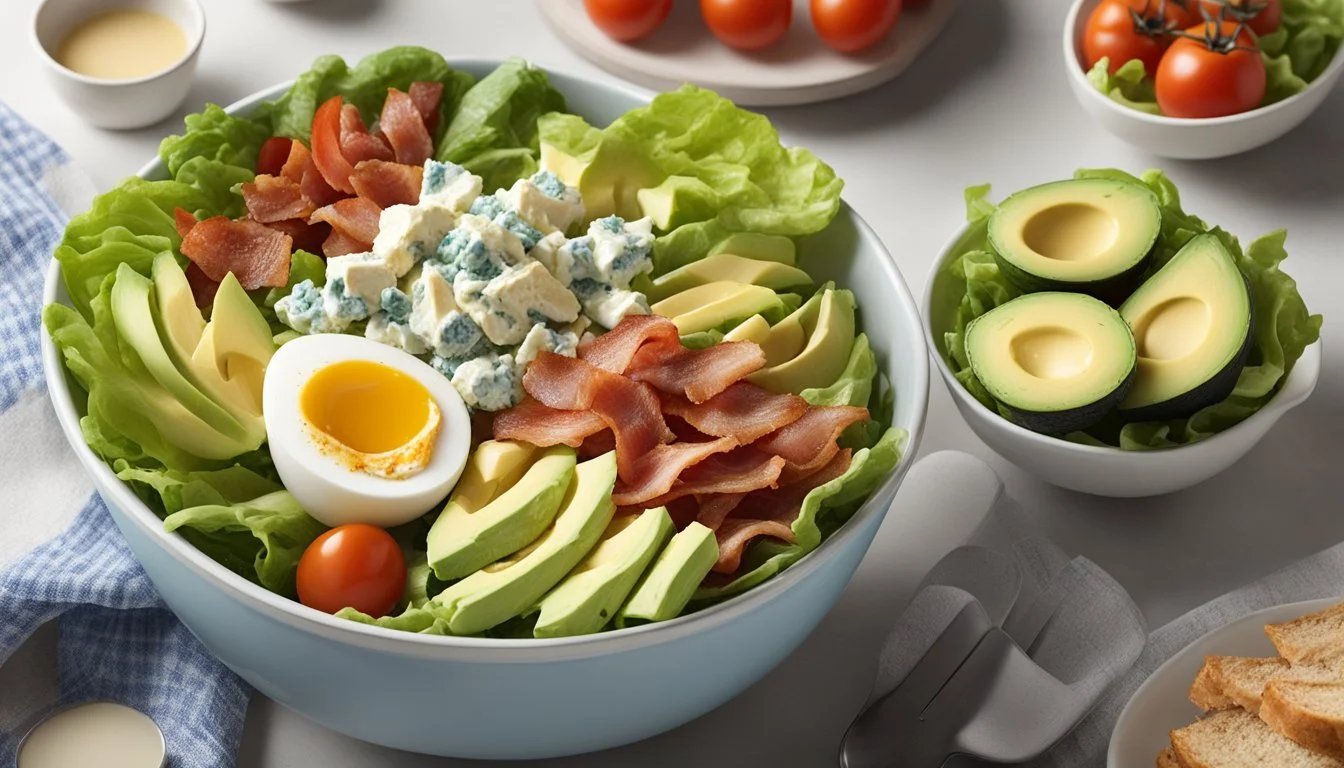Is Cobb Salad Gluten-Free?
Understanding Its Ingredients and Preparation
Cobb salad, a classic American garden salad, features a medley of ingredients such as lettuce, tomatoes, crisp bacon, grilled chicken, hard-boiled eggs, avocado, cheese, and an array of dressings. This assortment not only offers a variety of textures and flavors but also poses the question of whether it's suitable for those following a gluten-free diet. The answer largely depends on the individual components used in the salad.
Traditionally, cobb salad is considered gluten-free as it primarily consists of fresh vegetables, meats, and eggs—naturally gluten-free ingredients. However, caution is required when selecting items like dressings or cheeses, and particularly when including garnishes such as croutons, which typically contain gluten. Dressings too can harbor gluten-containing additives, thickeners, or flavorings. It's crucial for those with celiac disease or gluten sensitivity to examine each component of the salad to ensure it aligns with their dietary needs.
For those preparing a gluten-free Cobb salad at home, the recipe can easily be tailored to ensure it remains free of gluten. This involves choosing gluten-free alternatives for dressing or making a homemade version with verified gluten-free ingredients. Additionally, when dining out, it's imperative to communicate dietary restrictions to avoid cross-contamination with gluten-containing products. Being knowledgeable about each ingredient and vigilant in preparation allows individuals to enjoy a Cobb salad that is both delicious and gluten-free.
Historical Background
The Cobb Salad is an American culinary classic reputed to have origins at the historic Brown Derby Restaurant in Los Angeles. It is widely accepted that the salad's inventor was Robert Cobb, the restaurant's owner. This legacy dish dates back to 1937, when Cobb, scouring the kitchen for something to eat, combined a variety of ingredients into a substantial salad.
Ingredients typically found in a classic Cobb Salad:
Lettuce
Tomato
Chicken
Bacon
Hard-boiled eggs
Avocado
Roquefort cheese
This melange was an instant success and became a trademark offering of the Brown Derby, intertwining the salad’s identity with the restaurant's fame. It showcased a combination of textures and flavors that typified the bold and varied character of American salads (What wine goes well with salads?).
The Brown Derby itself was more than just an eatery; it was a landmark on the Hollywood landscape. Its distinctive derby-hat shape contributed to its fame, and it quickly became a go-to spot for celebrities and movie stars, which added to the allure and popularity of the Cobb Salad. As the salad's fame grew, so did its reach, and it secured a place in dining establishments across the nation.
The Cobb Salad's notable presence in American cuisine has led to numerous variations in its preparation, ensuring that its legacy continues to evolve while maintaining its original appeal.
Cobb Salad Ingredients
A Cobb Salad combines a rich assembly of ingredients that cater to a variety of tastes while ensuring a blend of textures and flavors. Every component contributes to the overall heartiness and appeal of this popular dish.
Lettuce Varieties
The foundational green of a traditional Cobb Salad is typically romaine lettuce, often mixed with mixed greens for added variety and nutrition. These greens provide a crisp base that complements the richer toppings.
Proteins in Cobb Salad
Proteins are key in Cobb Salad, with chicken—commonly cooked chicken breast—being a staple. It's joined by bacon and hard-boiled eggs, which contribute to the salad's satisfying substance.
Vegetables and Cheese
Vegetables like avocado and tomatoes offer freshness and color. Cheese varietals, such as blue cheese, feta, or goat cheese, add a creamy texture and robust flavor.
Additional Toppings
Apart from the main ingredients, chives, olives, corn, and red onion are often included. These are typically diced or sliced thinly, providing bursts of flavor and enhancing the visual appeal of the salad.
Dressings for Cobb Salad
To finish, dressings such as homemade ranch—possibly containing a blend of buttermilk, avocado oil, Greek yogurt, Roquefort cheese, and spices like pepper and salt—are drizzled over the top. Olive oil can also be a base for lighter vinaigrettes.
Gluten-Free Considerations
When preparing a Cobb Salad, one must carefully select ingredients and dressings to ensure the meal remains gluten-free. Avoiding gluten contamination is equally crucial.
Identifying Gluten in Ingredients
Ingredients typically found in a Cobb Salad like lettuce, tomatoes, chicken, bacon, eggs, and avocado are inherently gluten-free. However, one should examine additives in pre-cooked items or processed goods such as deli meats, canned vegetables, or seasoned products, as they might contain gluten. For example, some pre-cooked bacon brands may include seasonings that have gluten-containing ingredients.
Blue Cheese: Often used in Cobb Salad, should be checked for any gluten-containing additives.
Croutons: Traditionally part of a Cobb Salad; gluten-free alternatives must be used or omitted.
Gluten-Free Dressing Options
Dressings can be a hidden source of gluten. Here are safe choices for dressing a gluten-free Cobb Salad:
Homemade Ranch: Made with a base of mayonnaise, sour cream, or Greek yogurt, seasoned with herbs and spices.
Red-Wine Vinaigrette: Combines red-wine vinegar, olive oil, and optional ingredients like Dijon mustard and finely grated Roquefort.
Pepperoncini Vinaigrette: A tangy option with pepperoncini brine, garlic, olive oil, and yogurt.
Preserved Lemon Dressing: A fragrant choice made from preserved lemon, olive oil, lemon juice, and mustard.
Preparation of these dressings at home can ensure they are gluten-free and tailored to individual taste preferences.
Precautions for Cross-Contamination
When preparing a gluten-free Cobb Salad at home, the following precautions should minimize the risk of cross-contamination:
Separate Utensils and Surfaces: Use clean utensils and cutting boards exclusively for gluten-free food preparation.
Ingredient Storage: Store gluten-free items separately from gluten-containing products.
Read Labels: Always read labels on store-bought items, even if they are labeled as gluten-free, for potential cross-contamination warnings.
These practices help maintain a gluten-free environment and ensure that every component of the Cobb Salad remains safe for those with gluten sensitivities.
Preparing Cobb Salad at Home
Creating a gluten-free Cobb salad at home is a simple yet satisfying way to enjoy a hearty and healthy meal. With the right ingredients and steps, anyone can put together this classic dish with a refreshing twist.
Choosing the Right Ingredients
A gluten-free Cobb salad hinges on selecting the appropriate components. The base typically includes:
Lettuce: A mix of chopped romaine and baby spinach provides a crisp texture.
Chicken: Grilled or baked chicken breast, cut into strips, offers lean protein.
Avocado: Dice a ripe avocado for creamy richness.
Eggs: Include hard-boiled eggs, peeled and chopped.
Tomatoes: Fresh, juicy tomatoes add flavor. Cherry or grape varieties work well.
Dressing: Opt for a gluten-free dressing such as a homemade ranch or vinaigrette.
For additional texture, sprinkle in shredded cheese and, if desired, gluten-free croutons. Be vigilant about ingredient labels to ensure they are free from gluten-containing additives.
Step-by-Step Assembly
Once the ingredients are prepared, follow these steps for assembling the Cobb salad:
Start with a generous layer of lettuce in a large bowl.
Arrange the chicken strips, diced avocado, chopped eggs, and halved tomatoes over the greens in neat rows or a pattern of choice.
If using, scatter shredded cheese and croutons over the top.
Drizzle with the desired amount of gluten-free dressing, and lightly toss the salad before serving to distribute the flavors.
Tips for Meal Prep and Leftovers
For those looking to meal prep, a Cobb salad can be a convenient option:
Separate Components: Pack ingredients in separate containers to keep textures intact and prevent sogginess.
Dressing on the Side: Always store dressing separately and add just before eating.
Leftovers: Reinvent leftovers into a wrap, add them to a soup, or mix into an omelet for a fresh take on subsequent meals.
When stored correctly, most of the salad components will last in the fridge for several days, making it a practical choice for busy schedules.
Health and Nutrition
Cobb Salad is a satisfying and versatile option for those seeking a healthy and nutritious meal. Whether one is aiming for a gluten-free diet or simply a balanced dinner, this dish can be tailored to fit dietary needs while providing essential nutrients.
Caloric and Nutritional Content
A traditional Cobb Salad consists of an array of ingredients such as lettuce, chicken, hard-boiled eggs, avocado, bacon, and cheese. These components contribute to a considerable intake of protein, crucial for muscle maintenance and repair. This protein-packed salad typically yields about:
350-500 calories per serving
30-40 grams of protein
20-30 grams of fat (mostly from avocado, olive oil, and eggs)
10-15 grams of carbohydrates
Portion control and ingredient choice are key if one is monitoring caloric intake, as toppings like cheese and dressings can add more calories.
Benefits of a Balanced Cobb Salad
A balanced Cobb Salad offers a wealth of health benefits owing to its diverse ingredients. Leafy greens such as spinach and romaine lettuce provide vitamins A and C, along with calcium and iron. The addition of avocado not only brings a creamy texture but also supplies healthy monounsaturated fats, beneficial for heart health. It is important to ensure that all components:
Are fresh and minimally processed
Include a variety of vegetables for a spectrum of nutrients
Contain lean proteins like chicken or turkey
Adapting Cobb Salad for Dietary Restrictions
Adapting a Cobb Salad to fit dietary restrictions like gluten-free or paleo diets is straightforward with a few modifications:
Ensure all ingredients, like dressings and cooked meats, are certified gluten-free
Exclude cheese and croutons for a paleo or dairy-free version
Opt for olive oil and vinegar-based dressings instead of creamy varieties to reduce added sugars and unhealthy fats
By customizing ingredient choices, individuals can enjoy a Cobb Salad that adheres to their dietary preferences without compromising on taste or nutrition.
Selection Criteria for Quality Ingredients
When creating a gluten-free Cobb salad, the quality of ingredients is paramount. This section guides you through choosing the best components, ensuring a delicious and safe meal for those with gluten sensitivities.
Lettuce Selection
For the salad base, romaine lettuce is a popular choice due to its crisp texture and nutritional value. Mixed greens can add variety and enhance the nutritional profile. Look for fresh, organic leaves free from wilting or browning.
Opting for Fresh Produce
Incorporate fresh produce such as avocado, providing creamy texture and healthy fats. Tomatoes add color and flavor, with cherry tomatoes making a juicy and convenient option. Consider adding thinly sliced red onion for a crunch and a mild spicy note.
Choosing Proteins Wisely
The proteins should be gluten-free, with chicken and bacon often being the centerpiece. Choose grilled or baked chicken without marinades to avoid hidden gluten. For bacon, select uncured, naturally processed options. Eggs or hard-boiled eggs are excellent for added texture and protein; ensure they are cooked and handled separately from gluten-containing ingredients.
Selecting Real Cheeses
When it comes to cheese, genuine shredded cheese varieties like blue cheese, feta, goat cheese, or roquefort can elevate your salad. However, always double-check for gluten as some cheeses may contain additives that are not gluten-free.
Preferred Oils and Dressings
Choose high-quality oils like avocado oil or olive oil for dressings, renowned for their health benefits and purity. Consider making a homemade salad dressing with Greek yogurt as a base to ensure it's gluten-free and to add a tangy flavor. Avoid pre-made dressings that can contain gluten or unwanted preservatives.
Variations of Cobb Salad
A Cobb Salad is traditionally known for being a hearty dish that can serve as a full meal, often featuring chicken breast as a primary protein. The classic Cobb Salad includes chopped chicken breast, bacon, hard-boiled eggs, avocado, cheese, and a variety of greens like lettuce. It's a versatile salad that has inspired numerous variations while remaining a staple option for dinner or as a fulfilling meal any time of the day.
Classic Chicken Cobb Salad: It consists of the following components.
Greens: Typically lettuce.
Protein: Chicken breast, often grilled and diced.
Eggs: Hard-boiled and sliced or chopped.
Avocado: Adds creaminess with its diced flesh.
Bacon: Provides a crispy, savory touch.
Cheese: Usually blue cheese, although other types can be used.
Dressing: Often a robust ranch or a tangy vinaigrette.
Gluten-Free Variants: To ensure the salad is gluten-free, the croutons are omitted or replaced with a gluten-free alternative, and diners need to check that the dressing used is also free from gluten.
For those who enjoy chicken but prefer a lighter salad, a Chicken Caesar Salad can be a good alternative. This salad typically includes romaine lettuce, grilled chicken breast, Parmesan cheese, croutons (which should be excluded or substituted for a gluten-free version), and Caesar dressing.
Adaptable Salads for Dinner: The Cobb Salad's inherent flexibility allows it to cater to different dietary preferences and restrictions. For instance, for a dairy-free option, the cheese can be omitted or replaced with a dairy-free alternative. Similarly, vegetarians might substitute the chicken and bacon for grilled tofu (What wine goes well with grilled tofu?) or a variety of beans.
The array of ingredients offers contrasting textures and flavors, from creamy avocado to the crunch of bacon, making each forkful a diverse taste experience. With such adaptability, salads like the Cobb continue to be a popular and satisfying option for those seeking a nutrient-rich, customizable meal that can be easily adjusted to meet specific dietary needs.
Cobb Salad in Culinary Culture
Cobb Salad has cemented its status as an American classic, evolving from its Los Angeles origins to influence salad recipes across the globe and feature prominently on restaurant menus.
Cobb Salad's Place in American Cuisine
The Cobb Salad has become a staple of American cuisine since it was first concocted at the Brown Derby Restaurant in Los Angeles. This iconic eatery is credited with the creation of the salad in the late 1930s, and since then, the dish has become synonymous with American salad culture. Renowned for its colorful layers and hearty ingredients, the Cobb Salad offers a blend of lettuce, tomato, crisp bacon, boiled eggs, chicken, avocado, cheese, and a signature dressing that typically includes red-wine vinegar and Dijon-style mustard.
Influence on Salad Recipes Globally
Cobb Salad's combination of proteins and greens has had a considerable influence on salad recipes around the world. Chefs from various countries have adapted the core principles of the Cobb—providing a balanced mix of flavors and textures—to cater to local tastes and ingredients. This has led to the emergence of globally-inspired variants that retain the essence of the original recipe while introducing unique cultural twists, ensuring the Cobb Salad's place in the international culinary scene.
Cobb Salad in Restaurant Menus
Restaurants across the United States frequently feature the Cobb Salad on their menus, attesting to its enduring popularity. The salad's versatility makes it a common sight not just in Californian eateries but also in establishments nationwide, ranging from casual diners to upscale dining rooms. It is often presented with a choice of dressings and occasionally variations in toppings, allowing diners the flexibility to personalize their meal. Additionally, the gluten-free nature of the traditional Cobb Salad has allowed it to remain a favorite among health-conscious and dietary restriction-adhering guests.
Conclusion
A traditional Cobb Salad can align with a gluten-free diet when prepared with careful consideration of each ingredient. The foundational components of Cobb Salad—lettuce, chicken, hard-boiled eggs, avocados, tomatoes, cheese, and bacon—are inherently gluten-free. However, it is crucial to ensure that no gluten-containing products are used, especially in items like dressings or additives.
For a healthful approach, individuals may opt for lean chicken, omit cheese to reduce fat content, and select a gluten-free dressing. Avocados provide healthy fats, making the salad more satiating, and the variety of vegetables contributes to the overall nutrient density of the meal.
When meal prepping, one can arrange the salad ingredients in separate containers to maintain freshness. Dressing should be kept aside and added just before consumption to preserve the texture of the salad. Below is the general guideline for a gluten-free Cobb Salad:
Lettuce: Romaine or baby spinach
Protein: Grilled chicken, boiled eggs, and bacon
Fat: Avocado, cheese (if included), and a gluten-free dressing
To ensure the salad is gluten-free, scrutinize labels for hidden gluten in pre-cooked ingredients and confirm that all spices and condiments are safe. In summary, Cobb Salad is a versatile and adaptable dish that can be tailored to fit within a gluten-free and health-conscious lifestyle when prepared with attention to detail.









